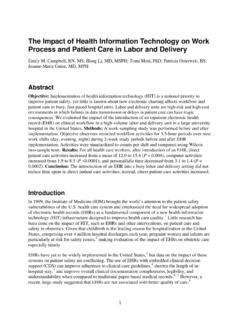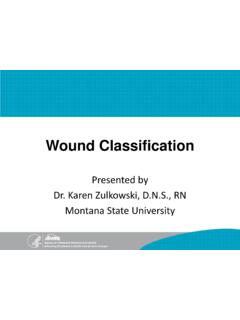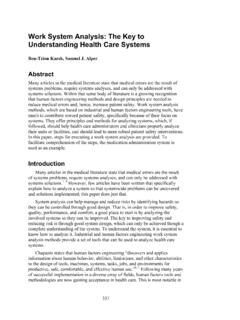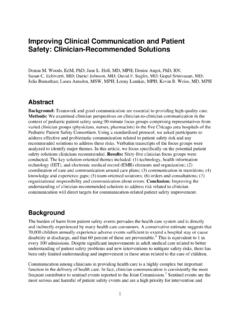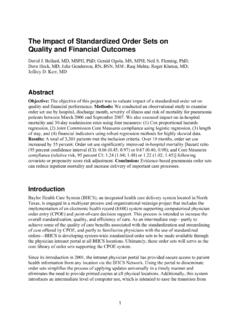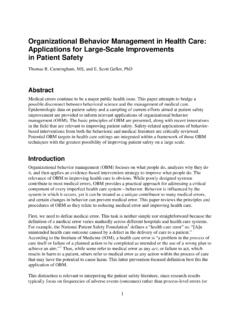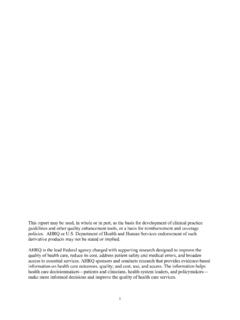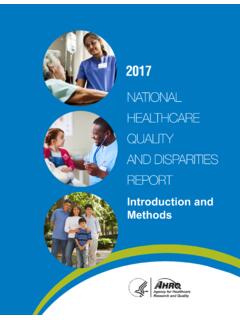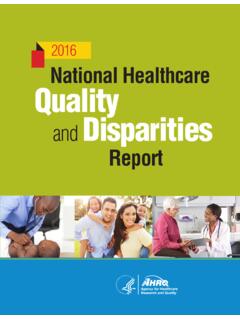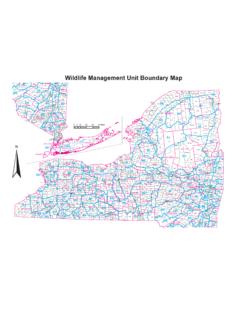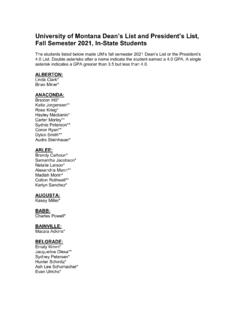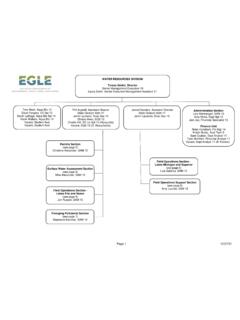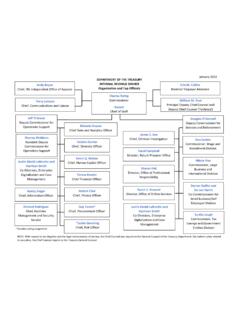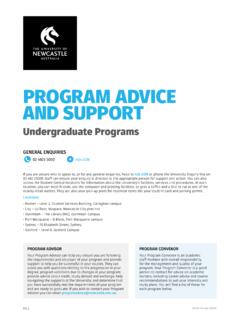Transcription of 2021 National Healthcare Quality and Disparities Report ...
1 2021 National Healthcare Quality and Disparities ReportIntroduction and MethodsThis document is in the public domain and may be used and reprinted without permission. Citation of the source is appreciated. Suggested citation: 2021 National Healthcare Quality and Disparities Report Introduction and Methods. Rockville, MD: Agency for Healthcare Research and Quality ; December 2021. AHRQ Publication (22)-0054-EF. 2021 National Healthcare Quality and Disparities Report Introduction and Methods DEPARTMENT OF HEALTH AND HUMAN SERVICES Agency for Healthcare Research and Quality 5600 Fishers Lane Rockville, MD 20857 AHRQ Publication No.
2 21(22)-0054-EF December 2021 ACKNOWLEDGMENTS The National Healthcare Quality and Disparities Report (NHQDR) is the product of collaboration among agencies from the Department of Health and Human Services (HHS), other federal departments, and the private sector. Many individuals guided and contributed to this effort. Without their magn an imo us support, the Report would not have been possible. Specifically, we thank: Primary AHRQ Staff: David Meyers, Jeff Brady, Erin Grace, Karen Chaves, Darryl Gray, Barbara Barton, Romsai Boonyasai, Irim Azam, Cecilia Hahn, and Doreen Bonnett. HHS Interag ency Workg roup (IWG) for the NHQDR.
3 Girma Alemu (HRSA), Irim Azam (AHRQ), Andreea Balan-Cohen (IMPAQ), Barbara Barton (AHRQ), Doreen Bonnett (AHRQ), Deron Burton (CDC), Victoria Chau (SAMHSA), Karen Chaves (AHRQ), Xiuhua Chen (Atlas Research), Deborah D u ra n (N IH-NIMHD), Melissa Evans (CMS), Camille Fabiyi (AHRQ), Darryl Gray, (AHRQ), Kirk Greenway (IHS), Sarah Heppner (HRSA), Ed Huff (CMS), DeLoris Hunter (NIH-NIMHD), Susan Jenkins (ACL), Christine Lee (FDA), Doris Lefkowitz (AHRQ), Jesse Lichstein (HRSA), Lan Liang (AHRQ), Shari Ling (CMS), Iris Mabry-Hernan dez (AHRQ), Marlene Matosky (HRSA), Tracy Matthews (HRSA), Christine Merenda (FDA), Kamila Mistry (AHRQ), Ernest Moy (VHA), Samia Noursi (NIH-NIDA), Kathy O Connor (CDC), Rajasri Roy (NIH-OD-ORWH), Dianne Rucinski (OASH), Asel Ryskulova (CDC), Adelle Simmons (ASPE), Robin Streeter (HRSA), Loida Tamayo (CMS), Caroline Taplin (ASPE), Emmanuel Taylor (NIH-NCI), Michelle Washko (HRSA), and Ying Zhang (IHS).
4 NHQDR Team: Irim Azam (CQuIPS), Barbara Barton (CQuIPS), Doreen Bonnett (OC), (CQuIPS), Xiuhua Chen, (Atlas Research), James Cleeman (CQuIPS), Camille Fabiyi (OEREP), Erin Grace (CQuIPS), Darryl Gray (CQuIPS), Cecilia Hahn (CQuIPS), Lan Liang (CFACT), Kamila Mistry (OEREP), Margie Shofer (CQuIPS), Abigail Woodroffe (IMPAQ). HHS Data Experts: Cuong Bui (HRSA), Lara Bull (CDC), Robin Cohen (CDC-NCHS), Joann Fitzell (CMS), Elizabeth Goldstein (CMS), Shiromani Gyawali (SAMHSA), Irene Hall (CDC-HIV), Pradip Muhuri (AHRQ), Jessica King (NPCR), Amanda Lankford (CDC), Denys Lau (CDC-NCHS), Lan Liang (AHRQ), Sharon Liu (SAMHSA), Marlene Matosky (HRSA), Tracy Matthews (HRSA), Robert Morgan (CMS), Richard Moser (NIH-NCI), Kathy O Connor (CDC-NCHS), Krishna Palipudi (SAMHSA), Robert Pratt (CDC), Asel Ryskulova (CDC-NCHS), Alek Sripipatana (HRSA), Reda Wilson (CDC- NCCDPHP-ONDIEH), and Xiaohong (Julia) Zhu (HRSA).
5 Other Data Experts: Mark Cohen (ACS NSQIP), Ashley Eckard (University of Michigan), Sheila Eckenrode (MPSMS-Yale), Clifford Ko (ACS NSQIP), Vivian Kurtz (University of Michigan), Leticia Nogueira (American Cancer Society), Robin Padilla (University of Michigan KECC), Yun Wang (MPSMS-Yale), and Robin Yabroff (American Cancer Society). Other AHRQ Contributors: Cindy Brach, Edwin Lomotan, Karen Migdail, Pamela Owens, Wendy Perry, Mary Rolston, Bruce Seeman, and Michele Valentine. Data Support Contractors: Atlas Research, IMPAQ International. CONTENTS Background on the National Healthcare Quality and Disparities Report and Related Chartbooks 1 Changes to the National Healthcare Quality and Disparities 2 2021 Report .
6 2 Changes to Past Reports ..3 Organization of the 2021 National Healthcare Quality and Disparities Report .. 5 Methods of the National Healthcare Quality and Disparities Report and Related Chartbooks .. 6 Data Populations ..10 Analyses ..13 Analysis Limitations ..20 Reporting Conventions .. 26 References .. 27 2021 National Healthcare Quality and Disparities Report 1 INTRODUCTION AND METHODS This Introduction and Methods document provides background on the annual National Healthcare Quality and Disparities Report (NHQDR) and modifications that have occurred over time. This document includes an overview of the methods used to generate estimates, measure trends, and examine Disparities .
7 Background on the National Healthcare Quality and Disparities Report and Related Chartbooks For the 19th year in a row, the Agency for Healthcare Research and Quality (AHRQ) has reported on progress and opportunities for improving Healthcare Quality and reducing Healthcare d isparities. As mandated by the Congress, the Report focuses on National trends in the Quality of health care provided to the American people (42 299b-2(b)(2)) and prevailing Disparities in health care delivery as it relates to racial factors and socioeconomic factors in priority populations (42 299a1(a)(6)).
8 The NHQDR is produced with the support of a Department of Health and Human Services (HHS) Interagency Work Group (IWG)i and guided by input from AHRQ s National Advisory Council and the Institute of Medicine (IOM), now known as the Health and Medicine Division of the National Academies of Sciences, Engineering, and Medicine. The 2021 Report tracks about 230 Healthcare process, outcome, and access measures, covering a wide variety of conditions and settings. Data years vary across measures; most trend analyses include data points from 2000-2002 to 2013-2019. An exception is rates of uninsurance, which are reported through 2021.
9 Measures used in the NHQDR fall into two categories: Core measures are used in the main NHQDR, or core Report . These summarize the status of overall Quality , status of Disparities , and trends in Quality and Disparities . Core measures are approved by the IWG for inclusion and are nationally representative. AHRQ receives these data regularly. Supplemental measures are not discussed in the core Report , except to highlight important topical issues. Supplemental measures are typically new measures and/or have limited data availability. These measures have not been approved by the IWG for inclusion in the core measure set and core measure summary analyses.
10 Both categories of measures are available in the Data Query Tool. i Federal participants on IWG: AHRQ, Administration for Children and Families, Administration for Community Living, Assistant Secretary for Planning and Evaluation, Centers for Disease Control and Prevention, Centers for Medica re & Medica id Services, Food and Drug Administration, Health Resources and Services Administration, Indian Health Service, National Institutes of Health, Office of the Assistant Secretary for Health, Substance Abuse and Mental Health Services Administration, and Veterans Health Administration.

